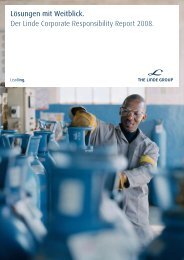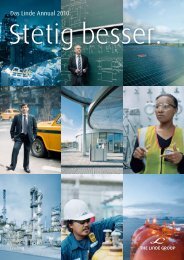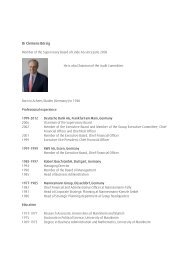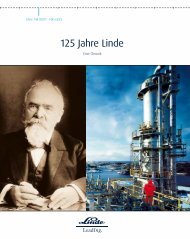The complete history of the development of The - The Linde Group
The complete history of the development of The - The Linde Group
The complete history of the development of The - The Linde Group
Create successful ePaper yourself
Turn your PDF publications into a flip-book with our unique Google optimized e-Paper software.
<strong>The</strong> <strong>Linde</strong> Company was surrounded from<br />
its very inception by so-called inventorengineers<br />
– as both employees and outside<br />
advisers. <strong>The</strong>se included, for instance, Rudolf<br />
Diesel, who worked for <strong>Linde</strong> for 13 years,<br />
Mathias Fränkl and Paulus Heylandt.<br />
Rudolf Diesel (1858-1913) was born<br />
in Paris and studied engineering at <strong>the</strong><br />
Technical University <strong>of</strong> Munich under Carl<br />
von <strong>Linde</strong>. After receiving an honors-level<br />
examination score and completing a<br />
practical placement at Sulzer in Switzerland,<br />
he went to Paris at <strong>the</strong> request <strong>of</strong><br />
Carl von <strong>Linde</strong> to manage <strong>the</strong> sales <strong>of</strong>fice<br />
<strong>the</strong>re starting in 1881. In 1890 Diesel<br />
became director <strong>of</strong> <strong>the</strong> <strong>Linde</strong>-Gesellschaft<br />
für Kühlhallen in Berlin.<br />
In addition to his work for <strong>Linde</strong>,<br />
Diesel designed an engine that was<br />
driven by an inexpensive fuel instead <strong>of</strong><br />
steam. When <strong>Linde</strong> declined to collabo-<br />
38<br />
N o 0743 Recovery <strong>of</strong><br />
krypton and xenon from oxygen.<br />
Rudolf Diesel, Paulus Heylandt and Mathias Fränkl:<br />
independent inventor-engineers<br />
Test run <strong>of</strong> <strong>the</strong> “Heylandt” rocket car at Tempelh<strong>of</strong> Field in Berlin, 1920s.<br />
Standing at <strong>the</strong> cockpit is Paulus Heylandt.<br />
1929 1930<br />
Stock market crash in New York on October 29 launches <strong>The</strong> Great Depression.<br />
rate on <strong>the</strong> fur<strong>the</strong>r <strong>development</strong> <strong>of</strong> this<br />
oil engine, Diesel handed in his notice<br />
and after 1893 <strong>the</strong>y went <strong>the</strong>ir separate<br />
ways. In 1897 Diesel had his first engine<br />
built by <strong>the</strong> Krupp Company in Essen.<br />
<strong>The</strong> new engine soon became widely<br />
used, first as a stationary unit and soon<br />
after as a ship’s engine as well. It was<br />
only later used in standard production in<br />
<strong>the</strong> automobile. Diesel himself survived<br />
to witness only a small part <strong>of</strong> its success.<br />
Protracted patent disputes and business<br />
failures led to his suspected suicide in <strong>the</strong><br />
English Channel during <strong>the</strong> crossing to<br />
England.<br />
Mathias Fränkl (1877-1947) was head<br />
<strong>of</strong> a pipe and tube factory in Bochum.<br />
After <strong>the</strong> end <strong>of</strong> <strong>the</strong> war, he founded<br />
several small machinery plants, including<br />
Maschinenfabrik Augsburg-Plattling<br />
Aktiengesellschaft (MAPAG) in 1923.<br />
N o 0756<br />
Transport <strong>of</strong> liquefied gases.<br />
From left to right: Rudolf Diesel, Moritz Schröter<br />
and Heinrich von Buz at <strong>the</strong> presentation <strong>of</strong> <strong>the</strong><br />
diesel engine in Kassel (1897).<br />
In 1925 he applied for a patent on <strong>the</strong><br />
alternating switch-over operation <strong>of</strong> heat<br />
exchangers (regenerators). His idea was<br />
first to cool <strong>the</strong> heat exchangers and <strong>the</strong>n<br />
in <strong>the</strong> second step to remove <strong>the</strong> cold<br />
(alternating operation). <strong>The</strong> <strong>Linde</strong>-Fränkl<br />
process, developed toge<strong>the</strong>r with <strong>Linde</strong>’s<br />
Department B, led to a breakthrough in<br />
oxygen top-blowing for steel production<br />
after <strong>the</strong> Second World War by allowing<br />
low-cost oxygen production. Fränkl died<br />
in 1947. MAPAG, located in <strong>the</strong> Bavarian<br />
city <strong>of</strong> Horgau, has been fully integrated<br />
in <strong>the</strong> <strong>Linde</strong> <strong>Group</strong> since 1990.<br />
Paulus Heylandt (1884-1947) was,<br />
like Fränkl, an autodidact. At <strong>the</strong> age <strong>of</strong><br />
18 he applied for patents for liquid air<br />
transport cylinders, and one year later built<br />
<strong>the</strong> first air liquefier. His most important<br />
invention was <strong>the</strong> gasifier tank from 1917,<br />
in which boiling liquid oxygen could be<br />
Max Schmeling becomes <strong>the</strong> first German<br />
world boxing champion in all classes.<br />
Mathias Fränkl, founder <strong>of</strong> MAPAG.<br />
transported. In 1923 <strong>the</strong> <strong>Linde</strong> Company<br />
signed a cooperative agreement with<br />
Heylandt AG for industrial gas recycling<br />
and invested in <strong>the</strong> company.<br />
In <strong>the</strong> late 1920s, Heylandt began<br />
experimenting with rocket propulsion<br />
vehicles. After 1945 he was abducted to<br />
<strong>the</strong> Soviet Union, where he passed away<br />
in 1947.<br />
Right: In <strong>the</strong> oxygen machinery assembly hall<br />
in Berlin-Britz; Paulus Heylandt (right) and his<br />
employee Michael Laschin.



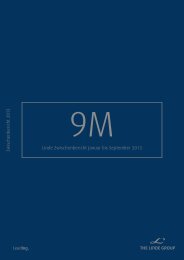
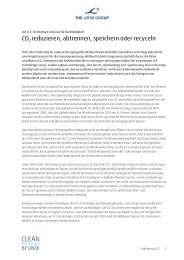

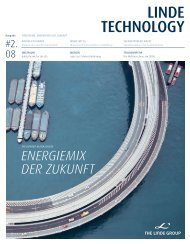
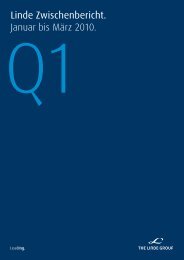
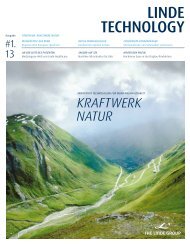
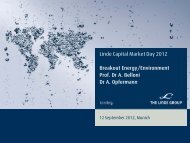
![[41] Anteilsbesitzliste des Linde Konzerns und ... - The Linde Group](https://img.yumpu.com/8356102/1/184x260/41-anteilsbesitzliste-des-linde-konzerns-und-the-linde-group.jpg?quality=85)
![[41] Anteilsbesitzliste des Linde Konzerns und ... - The Linde Group](https://img.yumpu.com/8356076/1/184x260/41-anteilsbesitzliste-des-linde-konzerns-und-the-linde-group.jpg?quality=85)
